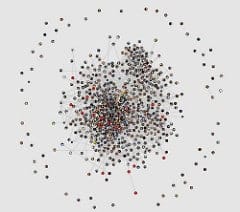 Social Graph by Rafiq Phillips via Flickr
Social Graph by Rafiq Phillips via Flickr
From today&39;s Social Media Insider in MediaPost
The Social Graph Ad Targeting Buyer's Guide
The "what&39;s next" in ad targeting is well upon us: targeting consumers based on their social graphs.
If
you&39;re an advertiser or you represent one, you may have tried targeting
consumers based on when they were born and their chromosomal makeup
(demographic), where they live or happen to be at the moment
(geographic), what they&39;re viewing on a Web page (contextual), what
other Web sites they&39;ve visited (behavioral), or what keywords they&39;re
entering in a query box (search engine marketing). Yet now it&39;s
possible to target consumers based on their associations with each
other.
This new form of ad targeting may not have a great name yet; last week I brought up one idea for a social naming convention
and we&39;ll probably need others. The concept revolves around targeting
consumers based on their social graph, or the map of who they&39;re
connected to. The theory is that if I expressed interest the movie
"Bruno," then some of my closest connections would also be interested,
and they should be targeted in turn. In that case, if the advertiser
targeted my friend Don Steele and my dad, two people close to me in my
graph, it would have found a receptive audience. Granted, the
advertiser might not have done so well targeting my wife and
mother-in-law, who were not as keen to see a movie about the
self-described "biggest Austrian celebrity since Hitler."
The
theory of targeting the social graph is based on some established
research, such as a landmark 2006 study from Wharton School of the
University of Pennsylvania Professor Shawndra Hill. Knowledge@Wharton reported in 2007:
The study examines the influence of social networks by studying a large
telecommunications firm that was marketing a new service. &39;"Network
neighbors — those consumers linked to a prior customer — adopt the
service at a rate three to five times greater than baseline groups
selected by the best practices of the firm&39;s marketing team," the study
finds. "In addition, analyzing the network allows the firm to acquire
new customers who otherwise would have fallen through the cracks,
because they would not have been identified based on traditional
attributes."
The study had its limitations, though. The
network effect was much stronger for a new technological service the
firm was promoting than it was for a new pricing plan. One theory is
that the network effect is much stronger when the product or brand
promoted lends itself to organic word-of-mouth buzz. Far more research
is needed across more verticals to provide a clear understanding of
what&39;s happening. Hopefully more will come from Professor Hill and
others in academia, but certain social graph ad targeting companies
could help fill in some gaps.
I&39;ve met with a number of such companies recently, including 33 Across, Media 6 Degrees, Lotame, and Socialmedia.com.
Unfortunately, I&39;ve given so many verbal non-disclosure promises that I
can&39;t share too much dirt about any one in particular, especially in
this secretive and competitive field. The good news is that I can offer
you something better: a buyer&39;s guide, with ten kinds of questions you
should ask when incorporating social graph ad targeting into your
campaigns. There aren&39;t always right answers, but this process will
help you better understand how this advertising works.
- Does the targeting work better for branding or direct response? Which
verticals have performed best to date? Which verticals or types of
campaigns haven&39;t worked as well? Certain targeting technologies are
designed more for transaction-based marketers, while others are much
better for branding.
- If it works better for
direct response, what kinds of responses can be measured? Is it more
about clicks and Web site visits, or can actions be tracked straight
through to conversions?
-
If branding is the
goal, what metrics are involved? Are they engagement metrics like
interactions and time spent? Can branding studies measure factors such
as awareness and purchase intent? - Is
retargeting involved? In other words, do marketers need to place a
pixel on their site to track its visitors? Several forms of social
graph ad targeting incorporate retargeting, which can be valuable for
the marketer. It&39;s still a notable difference from a standard ad
network buy. - Where does the social graph data come from?
- How transparent are the targeting and placements? Can certain types of consumers or placements be excluded?
-
What research has the company done to show how social graph ad
targeting compares with other methods like demographic or geographic
targeting? - What kind of scale is possible while still achieving the most pronounced effects for social graph targeting?
-
If a campaign works well and a custom segment or group was
created for this kind of targeting, can that same segment be used
repeatedly? How applicable are the learnings from one campaign to the
next? - How aware is the consumer of what&39;s
happening? What&39;s the consumer experience like? Is there a way for
consumers to opt out of this? What privacy protections are in place?
I&39;m
sure once you start approaching to these companies and others in the
field, more questions will come up, but this should get them talking,
and it should give you a good idea of what you&39;ll get out of social
graph targeting.



![Reblog this post [with Zemanta]](http://img.zemanta.com/reblog_e.png?x-id=44b9a712-d5f1-4ba6-b3ee-99d70820d511)



People reacted to this story.
Show comments Hide commentsIt would be interesting to see the Wharton study done in a context outside of telecom services.
This paragraph is key:
Another possibility is that because people often tend to talk to people like themselves, their buying tastes would be similar regardless of whether they ever discuss the product. “Social theory tells us that people who communicate with each other are more likely to be similar to each other, a concept called homophily,” the researchers point out. “…Linked consumers probably are like-minded, and like-minded consumers tend to buy the same products.”
And then this statement: “In addition, analyzing the network allows the firm to acquire new customers who otherwise would have fallen through the cracks, because they would not have been identified based on traditional attributes.”
If you seriously look at non network graph analysis tools, the traditional regression based ones, you should find ways (attributes- demographics, psychographics) of reaching out to your target audience.
The more successful network graph firms would use a mix of the two, however, this is not about tools. This is about reaching customers, if we take the words social media out of the equation.
This goes back to the theme I have encountered- marketing following social media. Did I say I need to be in or around an agency, now? 🙂
Totally agreed that the mix will come into play. I’m just curious how far
social graph ad targeting will go in terms of how much it should be included
in that mix. Yes, we need far more search beyond telecom to figure this out.
Ad Targeting is getting better and better day by day.
And thanks for the post , i enjoyed reading.